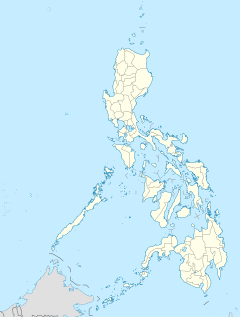ម៉ានីល
| អត្ថបទនេះត្រូវការបកប្រែទៅជាភាសាខ្មែរ។ អត្ថបទនេះត្រូវបានសរសេរជាភាសាផ្សេង ដែលមិនមែនជាភាសាខ្មែរ។ បើសិនជាអត្ថបទទុកសម្រាប់អ្នកអានមកពី សហគមន៍នៃភាសាមួយនេះ វាគួរតែចែកចាយទៅវិគីភីឌាជាភាសានោះ។ សូមមើល បញ្ជីនៃគម្រោងវិគីភីឌាទាំងអស់។ សូមមើល ច្រកចូលអត្ថបទនេះ លើក្រុមទំព័រដែលត្រូវការបំណកប្រែទៅជាភាសាខ្មែរ ដើម្បីពិភាក្សា ។ ប្រសិនបើ អត្ថបទមិនត្រូវបានសរសេរជាភាសាខ្មែរឡើងវិញទេ ក្នុងរយៈពេលពីរសប្ដាហ៍ទៀត អត្ថបទនឹងត្រូវចុះបញ្ជីដើម្បីលុបចោល និង/ឬ ប្ដូរវាទៅកាន់វិគីភីឌាជាភាសាដើមរបស់វាវិញ ។ បើសិនជាលោកអ្នក គ្រាន់តែចង់បិទស្លាកទំព័រនេះត្រូវការបំណកប្រែ សូមបញ្ចូល {{អាទេស.:ត្រូវការបកប្រែ | ទំ. = ម៉ានីល | ភាសា = មិនស្គាល់ | ផ្ដល់យោបល់ = }} ~~~~ទៅខាងក្រោម នៃផ្នែក នៃក្រុមទំព័រនេះត្រូវការបំណកប្រែទៅជាភាសាខ្មែរ ។ |
ម៉ានីល (អង់គ្លេស: Manila /məˈnɪlə/; Filipino: Maynila, [majˈnilaʔ]) គឺជារដ្ឋធានី និងជាទីក្រុងធំទី២នៃប្រទេសហ្វីលីពីន។ It is one of the sixteen cities (along with the municipality of Pateros) that make up the National Capital Region called Metro Manila which has a population of 12 million.
| City of Manila Lungsod ng Maynila | |||
|---|---|---|---|
| Capital City | |||
| |||
| រហស្សនាម: Pearl of the Orient[១] The City of Our Affections Distinguished and Ever Loyal City | |||
 | |||
| កូអរដោនេ: 14°35′N 120°58′E / 14.583°N 120.967°ECoordinates: 14°35′N 120°58′E / 14.583°N 120.967°E | |||
| Country | |||
| Region | National Capital Region | ||
| Districts | 1st to 6th districts of Manila | ||
| Kingdom of Maynila | 1500s | ||
| Spanish City of Manila | June 24, 1571 | ||
| Barangays | 897 | ||
| រដ្ឋាភិបាល[២] | |||
| • ប្រភេទ | Mayor–council | ||
| • Mayor | Joseph Estrada (UNA) | ||
| • Vice Mayor | Isko Moreno (UNA) | ||
| • Representatives | City Representatives
| ||
| • City Council | Councilors
| ||
| ផ្ទៃក្រឡា | |||
| • Capital City | ៣៨.៥៥ គម2 (១៤.៨៨ ម៉ាយ ការ) | ||
| • Urban | ១៤៧៤.៨២ គម2 (៥៦៩.៤៣ ម៉ាយ ការ) | ||
| • Metro | ៦៣៨.៥៥ គម2 (២៤៦.៥៥ ម៉ាយ ការ) | ||
| រយៈកំពស់ | ១៦.០ m (៥២.៥ ft) | ||
| ប្រជាជន (2010)[៣] | |||
| • Capital City | ១៦៥២១៧១ | ||
| • សន្ទភាព | ៤២៨៥៨/km2 (១១១០០០/sq mi) | ||
| • Urban | ២១,៩៥១,០០០ | ||
| • Urban density | ១៥៤០០/km2 (៣៩.៨៩/sq mi) | ||
| • Metro | ១១៨៥៥៩៧៥ | ||
| • Metro density | ១៨៥៦៧/km2 (៤៨០៩០/sq mi) | ||
| ប្រជានាម | Manileño (m) / Manileña (f), Manilan | ||
| ល្វែងម៉ោង | PST (ម.ស.ស.+8) | ||
| ZIP code | 0900 to 1096 | ||
| Area code | 2 | ||
| គេហទំព័រ | manila.gov.ph | ||
The City of Manila is located on the eastern shore of Manila Bay and is bordered by the cities of Navotas and Caloocan to the north; Quezon City to the northeast; San Juan to the northeast; Mandaluyong to the east; Makati to the southeast, and Pasay to the south.
Manila has a total population of 1,652,171 according to the 2010 census[៣] and is the second most populous city in the Philippines, behind Quezon City. The populace inhabit an area of only 38.55 square kilometers, making Manila the most densely populated city in the world.[៤][៥]
The city is divided into six legislative districts and consists of sixteen areas: Binondo, Ermita, Intramuros, Malate, Paco, Pandacan, Port Area, Quiapo, Sampaloc, San Andres, San Miguel, San Nicolas, Santa Ana, Santa Cruz, Santa Mesa and Tondo. Bustling commerce and some of the most historically and culturally significant iconic landmarks in the country, as well as the seat of the executive and judicial branches of the government are found in the city. Manila is also home to many scientific and educational institutions, numerous sport facilities, and other culturally and historically significant venues.
Listed as a global city, Manila has its strengths in the arts, commerce, education, entertainment, finance, healthcare, media, professional services, research and development, tourism and transport making it the historical, cultural, political, economic and educational center of the Philippines.[៦]
The earliest written account of the city is the 10th-century Laguna Copperplate Inscription which describes a context of an Indianised kingdom maintaining diplomatic relations with the Kingdom of Medang. The city was invaded by Brunei's Sultan Bolkiah and was already Islamized by the 15th century when the Spanish Conquistadors first arrived. Manila eventually became the center of Spanish activity in the Far East and one end of the Manila-Acapulco Galleon trade route linking Latin America and Asia. The city would eventually be given the moniker of the "Pearl of the Orient", as a result of its central location in the vital Pacific sea trade routes. Several Chinese insurrections, local revolts, a British Occupation and a Sepoy mutiny also occurred shortly thereafter. Manila also saw the rise of the Philippine Revolution which was followed by the arrival of the Americans who made contributions to the city's urban planning and development only to have most of those improvements lost in the devastation of World War II. Since then the city has been rebuilt.
- ↑ "'PEARL OF ORIENT' STRIPPED OF FOOD; Manila, Before Pearl Harbor, Had Been Prosperous—Its Harbor One of Best Focus for Two Attacks Osmeña Succeeded Quezon". New York Times. 1945-02-05. Retrieved 18-06-10.
Manila, modernized and elevated to the status of a metropolis by American engineering skill, was before Pearl Harbor a city of 623,000 population, contained in an area of fourteen square miles.
{{cite web}}: Check date values in:|accessdate=(help) - ↑ "Cities". Quezon City, Philippines: Department of the Interior and Local Government. Archived from the original on 9 មីនា 2013. Retrieved 30 November 2012.
- ↑ ៣,០ ៣,១ "Total Population by Province, City, Municipality and Barangay: as of May 1, 2010" (PDF). 2010 Census of Population and Housing. National Statistics Office of the Republic of the Philippines. Archived from the original (PDF) on 15 វិច្ឆិកា 2012. Retrieved 6 April 2012.
- ↑ Carbone, Nick (October 26, 2011). "The 10 Fastest-Growing Cities of Tomorrow". TIME. Archived from the original on 24 សីហា 2013. Retrieved 28 March 2013.
- ↑ "World's Densest Cities". Forbes Magazine. Retrieved 2010-05-04.
- ↑ "The World According to GaWC 2008". Globalization and World Cities Study Group and Network (GaWC). Loughborough University. Archived from the original on 11 សីហា 2016. Retrieved 7 December 2009.


